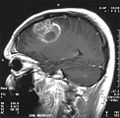ACNB: Glioblastoma
multiforme (GBM) is by far the most common and aggressive form of glial
tumor. It is characterized by a highly proliferative population of cells
that invade surrounding tissue and that frequently recur after surgical
resection and chemotherapy. Over the last decades, a number of
promising novel pharmacological approaches have been investigated, but
most of them have failed clinical trials due to some side-effects such
as toxicity and poor drug delivery to the brain. The major obstacle in
the treatment of GBM is the presence of the blood-brain barrier (BBB).
Due to their relatively high molecular weight, most therapeutic drugs
fail to cross the BBB from the blood circulation.
This
paper sheds light on the characteristics of GBM and the challenges of
current pharmacological treatments. A closer look is given to the role
of nanotechnology in the field of drug delivery, and its application in the treatment of brain tumors such as GBM.
For
this purpose, effort was made to select the most recent studies using
predefined search criteria that included at least one of the following
keywords in the PubMed and Medline databases: glioblastoma, drug
delivery, blood-brain barrier, nanotechnology, and nanoparticle.
Breakthrough in nanotechnology
offers promising applications in cancer therapy and targeted drug
delivery. However, more efforts need to be devoted to the development of
novel therapeutic strategies that enable the delivery of drugs to
desired areas of the brain with limited side-effects and higher
therapeutic efficiency.
